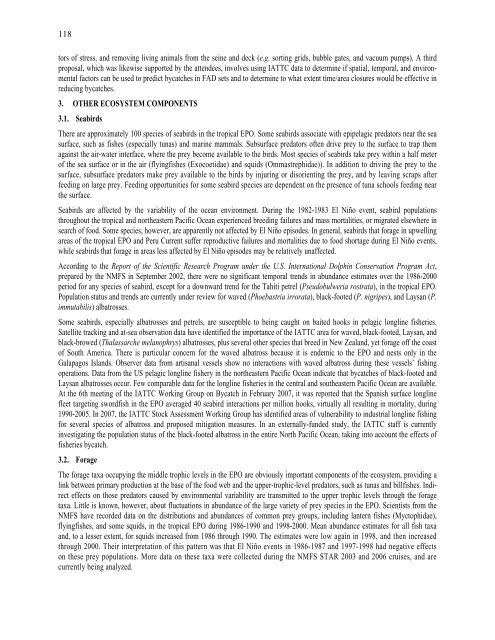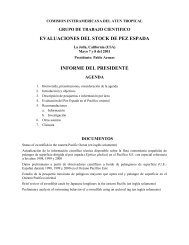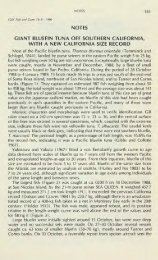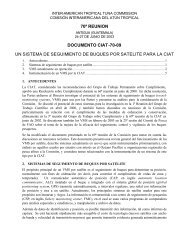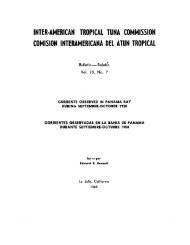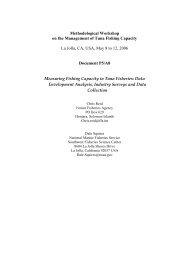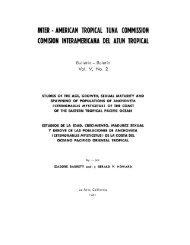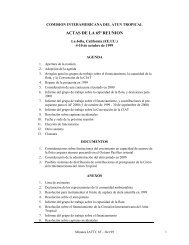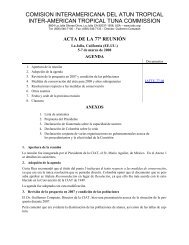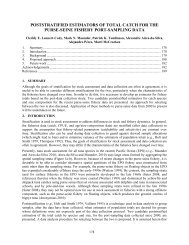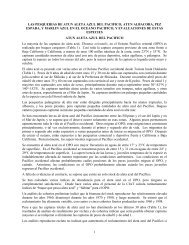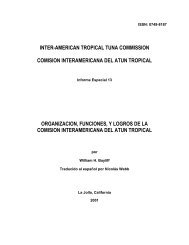INTER-AMERICAN TROPICAL TUNA COMMISSION - Comisión ...
INTER-AMERICAN TROPICAL TUNA COMMISSION - Comisión ...
INTER-AMERICAN TROPICAL TUNA COMMISSION - Comisión ...
- No tags were found...
You also want an ePaper? Increase the reach of your titles
YUMPU automatically turns print PDFs into web optimized ePapers that Google loves.
118tors of stress, and removing living animals from the seine and deck (e.g. sorting grids, bubble gates, and vacuum pumps). A thirdproposal, which was likewise supported by the attendees, involves using IATTC data to determine if spatial, temporal, and environmentalfactors can be used to predict bycatches in FAD sets and to determine to what extent time/area closures would be effective inreducing bycatches.3. OTHER ECOSYSTEM COMPONENTS3.1. SeabirdsThere are approximately 100 species of seabirds in the tropical EPO. Some seabirds associate with epipelagic predators near the seasurface, such as fishes (especially tunas) and marine mammals. Subsurface predators often drive prey to the surface to trap themagainst the air-water interface, where the prey become available to the birds. Most species of seabirds take prey within a half meterof the sea surface or in the air (flyingfishes (Exocoetidae) and squids (Ommastrephidae)). In addition to driving the prey to thesurface, subsurface predators make prey available to the birds by injuring or disorienting the prey, and by leaving scraps afterfeeding on large prey. Feeding opportunities for some seabird species are dependent on the presence of tuna schools feeding nearthe surface.Seabirds are affected by the variability of the ocean environment. During the 1982-1983 El Niño event, seabird populationsthroughout the tropical and northeastern Pacific Ocean experienced breeding failures and mass mortalities, or migrated elsewhere insearch of food. Some species, however, are apparently not affected by El Niño episodes. In general, seabirds that forage in upwellingareas of the tropical EPO and Peru Current suffer reproductive failures and mortalities due to food shortage during El Niño events,while seabirds that forage in areas less affected by El Niño episodes may be relatively unaffected.According to the Report of the Scientific Research Program under the U.S. International Dolphin Conservation Program Act,prepared by the NMFS in September 2002, there were no significant temporal trends in abundance estimates over the 1986-2000period for any species of seabird, except for a downward trend for the Tahiti petrel (Pseudobulweria rostrata), in the tropical EPO.Population status and trends are currently under review for waved (Phoebastria irrorata), black-footed (P. nigripes), and Laysan (P.immutabilis) albatrosses.Some seabirds, especially albatrosses and petrels, are susceptible to being caught on baited hooks in pelagic longline fisheries.Satellite tracking and at-sea observation data have identified the importance of the IATTC area for waved, black-footed, Laysan, andblack-browed (Thalassarche melanophrys) albatrosses, plus several other species that breed in New Zealand, yet forage off the coastof South America. There is particular concern for the waved albatross because it is endemic to the EPO and nests only in theGalapagos Islands. Observer data from artisanal vessels show no interactions with waved albatross during these vessels’ fishingoperations. Data from the US pelagic longline fishery in the northeastern Pacific Ocean indicate that bycatches of black-footed andLaysan albatrosses occur. Few comparable data for the longline fisheries in the central and southeastern Pacific Ocean are available.At the 6th meeting of the IATTC Working Group on Bycatch in February 2007, it was reported that the Spanish surface longlinefleet targeting swordfish in the EPO averaged 40 seabird interactions per million hooks, virtually all resulting in mortality, during1990-2005. In 2007, the IATTC Stock Assessment Working Group has identified areas of vulnerability to industrial longline fishingfor several species of albatross and proposed mitigation measures. In an externally-funded study, the IATTC staff is currentlyinvestigating the population status of the black-footed albatross in the entire North Pacific Ocean, taking into account the effects offisheries bycatch.3.2. ForageThe forage taxa occupying the middle trophic levels in the EPO are obviously important components of the ecosystem, providing alink between primary production at the base of the food web and the upper-trophic-level predators, such as tunas and billfishes. Indirecteffects on those predators caused by environmental variability are transmitted to the upper trophic levels through the foragetaxa. Little is known, however, about fluctuations in abundance of the large variety of prey species in the EPO. Scientists from theNMFS have recorded data on the distributions and abundances of common prey groups, including lantern fishes (Myctophidae),flyingfishes, and some squids, in the tropical EPO during 1986-1990 and 1998-2000. Mean abundance estimates for all fish taxaand, to a lesser extent, for squids increased from 1986 through 1990. The estimates were low again in 1998, and then increasedthrough 2000. Their interpretation of this pattern was that El Niño events in 1986-1987 and 1997-1998 had negative effectson these prey populations. More data on these taxa were collected during the NMFS STAR 2003 and 2006 cruises, and arecurrently being analyzed.


